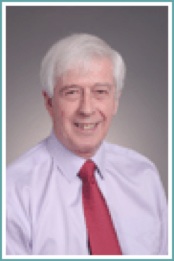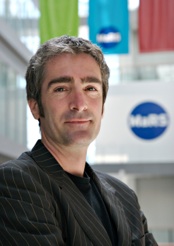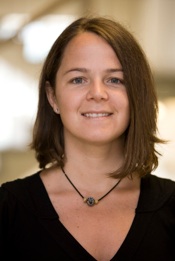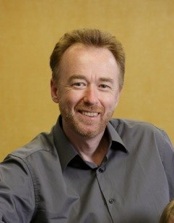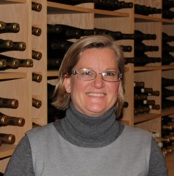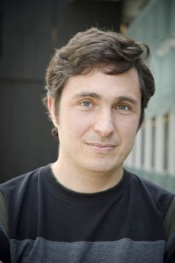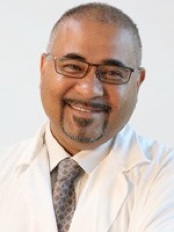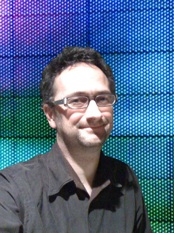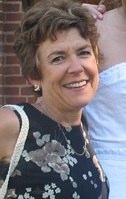



Table 1: Melanie Baljko, Associate Professor, Department of Computer Science and Engineering, York University
Interdisciplinarity at the Frontier of Human-Centered Computing: Community Engagement, Art, and Computer Science
We will discuss a number of issues at the cutting edge of computer science research, all of which involve interdisciplinary thinking and innovation. We will discuss the research efforts that focus on the development of technologies to assist individuals who have disabilities, why so little of this innovation reaches the marketplace, and what can be done to better engage communities of users. We will also discuss topics at the interface of art and computer science, particularly concerning the use of computer simulations to investigate life, its processes, and its evolution. We will see that the questions that artists and computer scientists ask are not so different from one another, although the modes of inquiry can be quite different. Finally, we will reflect on "maker" culture and how traditional modes of creative work are now being blended with 3D printing and new frontiers of computer literacy.
Melanie is an Associate Professor in the Department of Computer Science and Engineering at York, where she has conducted an interdisciplinary program of research for over ten years. Her research interests are oriented toward the design and evaluation of human-centred computational systems and interfaces, with a focus on assistive technology and interactive systems used to support human communication. She is particularly interested in the use of reflective and critical design practices and interdisciplinary collaboration. Melanie is an active member of the Association for Computing Machinery (ACM), her work has received funding from the National Science and Engineering Research Council of Canada, the Social Science and Humanities Research Council of Canada, and the Canada Council for the Arts.
Table 2: Susan Pfeiffer, Professor, Department of Anthropology, University of Toronto
Exploring the Origins of Modern Humans through African Archaeological Evidence
Questions about the fundamental nature of humans are based in part on assumptions about our antiquity. The evolution of our lineage is becoming better known. One of the most dramatic chapters in that story is the final one, in which humans who probably could speak, migrated out of Africa and populated large expanses of the world within a few thousand years. Is the model that arises from genetic and archaeological research plausible? To what extent was climate change a factor? Was inter-group aggression a factor? Competing hypotheses are diverse. The balance of the evidence shifts as new discoveries are made.
Susan is a Professor of Anthropology at the University of Toronto. Her research concentrates on reconstructing past human lives from characteristics of their bones and teeth. She pursues archaeologically based research in Lake Turkana, Kenya and South Africa, although study of eastern North American First Nations ancestral groups has also been a theme throughout her career. She is an honorary research associate of the Department of Archaeology, University of Cape Town. She has held various administrative positions, including U of T Vice-Provost for Graduate Education. She is a member of the Research Council of the Canadian Institute for Advanced Research (CIFAR).
Table 3: Adrian M Owen, Canada Excellence Research Chair (CERC) in Cognitive Neuroscience and Imaging, Western University
Searching for Consciousness
How can we ever know, unequivocally, that another person is conscious and aware? Notwithstanding deeper philosophical considerations about the nature of consciousness itself, the only reliable method we have for detecting awareness in others is by eliciting a predicted response to an external prompt or command, e.g. the squeeze of a hand or the blink of an eye. But what if the ability to make any physical response is impaired or lost altogether? This problem exposes a central conundrum in the study of awareness in general, and in particular, how it relates to the vegetative state, coma and other so-called ‘disorders of consciousness’. Is there a ‘lost’ population of patients who are awake, aware, but entirely non-responsive? If so, what can we do to find them and what does their very existence tell us about human consciousness?
Adrian is currently the Canada Excellence Research Chair (CERC) in Cognition and Neuroimaging at Western University. His work combines structural and functional neuroimaging with neuropsychological studies of brain-injured patients. His most recent work has shown that functional neuroimaging can reveal conscious awareness in some patients who appear to be entirely vegetative, and can even allow some of these individuals to communicate their thoughts and wishes to the outside world. These findings have attracted widespread media attention.
Table 4: Candace Kruttschnitt, Professor, Department of Sociology, University of Toronto
Crime and Anti-social Behaviour: Nature, Nurture or Both?
Physique, hormones, chromosomes, neuro-developmental disorders, exposure to risk factors, and socialization have all been identified as explanations for crime and for the most well known correlate of crime – sex. How well do these factors do when it comes to explaining “run of the mill” offences, extreme crimes that rarely occur but claim many victims, and trends in crimes over time and place? What are policy implications that flow from these different perspectives on the crime? We will consider these questions in light of both current crimes and current research findings.
Prior to joining the University of Toronto, Candace was Professor and Chair of the Department of Sociology at the University of Minnesota. The Royal Netherlands Academy of Arts and Sciences gave her a Visiting Professorship in 2010; she has also been a visiting fellow at the Institute of Criminology at Cambridge University and the University of Helsinki. She has served on the Committee on Law and Justice for the National Academy of Science (United States) and as Vice President of the American Society of Criminology.
Table 5: Carolyn Abraham, Science Journalist and Author
Everyone's Genome Tells a Story -- Do You Want to Know Yours?
It took $3 billion and a decade to map the first genome of a human being. Now, that same feat takes mere days and will soon cost less than a pair of designer shoes. Yet the technical ability to read DNA has dramatically outstripped the capacity to understand it, and science desperately needs more genomes to study. Would you provide yours? Our genes might hold the keys to personalized medicine, tomorrow’s treatments and possibly, cures. But you might also learn of health conditions that will never develop, or others you can do nothing about. Could it cost you the ability to obtain life insurance, or a job? Will it inspire you to improve your lifestyle, pull family skeletons out of the closet, or reveal information that could save your life?
Join Carolyn, award-winning science journalist and author, for a discussion around the thorny questions springing from this fledgling genomic age. The Globe and Mail’s senior medical writer for fourteen years, Carolyn recently produced a two-week series exploring these issues. She has also delved into her own family’s DNA to solve mysteries of her ancestry, an adventure documented in her new book, The Juggler’s Children. Her first book, Possessing Genius, told the story of the man who took Einstein’s brain, and was a finalist for the Governor General’s prize for literary non-fiction. Carolyn also co-wrote the National Film Board’s production of DNA and Dollars, wrote the chapter on Canada’s 2003 SARS outbreak at the request of the World Health Organization, and appears regularly as a commentator on the social implications of scientific advances.
Table 6: Debbie Inglis, Director, Cool Climate Oenology and Viticulture Institute, Brock University
Icewine - The Making of Canada’s Iconic Dessert Wine
Canada is the largest producer by volume of Icewine – one of the world’s truly unique beverages. That uniqueness comes at the price of pushing winemakers to their wits’ end. Some winemakers have termed the gruelling process ‘Extreme Winemaking’. From draping the crop in miles of awkward netting to thwart bird attacks, to picking in the middle of bone-chilling nights, to the irksome stickiness on everything it contacts in your winery, making Icewine can be a ruthless pursuit. And the sticky stuff doesn’t ease up when it comes to fermenting it. This is when it puts yeast through the microbial equivalent of Marine Corps basic training. Debbie will unveil the ‘frozen truth’ about Icewine production; what it truly takes to make Canada’s ultra-premium dessert wine, and the research from Brock’s Cool Climate Oenology and Viticulture Institute that supports this Canadian icon.
Debbie is currently the Director of Brock University’s Cool Climate Oenology and Viticulture Institute (CCOVI) and a faculty member in the Department of Biological Sciences at Brock University. She holds a PhD in Biochemistry and after spending three years as a senior scientist in industry, returned to academia specifically to join CCOVI. Her main research focuses on yeast stress responses during Icewine fermentation and factors affecting Icewine quality. In addition, she studies the etiology of Grape Sour Rot in Niagara to develop control strategies in the vineyard and has initiated a program to improve wine quality as part of CCOVI’s focus on premium wine production. Debbie has been involved in the grape and wine industry her entire life as her family are grape growers in the Niagara Peninsula and she and her husband Rob run their own vineyard in Niagara on the Lake.
Table 7: Emma Allen-Vercoe, Associate Professor, Department of Molecular and Cellular Biology, University of Guelph
Minding Your Microbes: Your Gut Microbial Ecosystem Needs You (and You Need It!)
Many of us are unaware of the microbial world that lives on us and in us, yet in the last decade we have begun to understand that these microbes are vital to our health and wellbeing. Those microbes that live in our guts are arguably the most important of all. How do creatures so tiny have such a great influence on us? Why do we know so little about them? What are the consequences of living our ultra-clean modern lifestyle on our personal microbial zoos? We will discuss how damage to the gut microbial ecosystem has far reaching effects on diseases from asthma to autism, and Emma will outline her vision of the future of medicine in which minding our microbes will be a key to good health.
Emma did her undergraduate and graduate training in biochemistry and microbiology in the UK, culminating in a PhD in molecular microbiology in 1999. During this training, she realized that ‘health research’ was actually more than the study of disease, and that to make more progress in this field, it is necessary to first define health – something that has rarely been addressed. To this end, in 2008 she set up her laboratory at the University of Guelph for her and her team to study the microbes resident in the human gut and their contribution to health, using a unique research tool dubbed ‘The Robogut’.
Table 8: Suresh Narine, Professor of Physics & Astronomy and Chemistry; Director, Trent Centre for Biomaterials Research
Remaking the World: The Promise of Biomaterials
Our world is truly a material one - without modern materials, mostly derived from petrochemicals, our safety, creature comforts, transportation, defence, art, literature, music, and pollution, would be drastically different. The ubiquity of petrochemical materials helps shape our culture, values and entire way of life. At the same time, the utilization of petroleum resources results in grave challenges to climate change through global warming, and the very robustness of modern materials provides vexing challenges to disposal once they have reached the end of their utility. An opportunity exists to remake our material world, utilizing the planet.s abundant biomass resources, and in so doing define sustainable and environmentally friendly, but culturally and economically viable ways of producing replacement materials.
Originally from Guyana, Suresh was named as one of Canada’s Top 40 Under 40 Leaders. He was Professor and AVAC Research Chair, NSERC Industrial Research Chair in Lipid Utilization, and the founding Director of the Alberta Lipid Utilization Research Program at the University of Alberta. In 2005, Suresh accepted a presidential appointment as the Director of Guyana's Institute of Applied Science and Technology. In 2009, Suresh was recruited back to Ontario to join his alma mater, Trent University, as a Professor in the Departments of Physics & Astronomy and Chemistry, and as the Director of the Trent Centre for Biomaterials Research. He became Ontario Research Chair in Green Chemistry and Engineering and also holds a senior research chair from NSERC in partnership with Elevance Renewable Sciences, Inc. and the Grain Farmers of Ontario.
Table 9: Karen E Yeates, BSc, MD, FRCP(C) MPH, Co-Director, Queen's School of Medicine Office of Global Health; Director, Pamoja Tunaweza Women's Centre, Moshi. Tanzania
A Global Health Paradigm: Health & Chronic Disease in Tanzania
Karen will discuss aspects of global health including global cardiovascular and kidney disease prevention and outcomes as well as health policy issues in Aboriginal Health, primarily in access to care and examining methods to improve on the ways that Aboriginal people access the health care system. The use of simple technology, e.g. mobile phone technology, to improve disease detection in low and middle income countries and in low-resource/rural or isolated communities in Canada and in rural areas of Tanzania will be a focus of the discussion.
Karen is a graduate of Queen’s Medical School who trained in Internal Medicine in Toronto and then completed a fellowship in Nephrology at Queen’s University combined with a Master in Public Health from Harvard University. She is currently a staff nephrologist and Assistant Professor in the Department of Medicine at Queen’s University. She co-developed the Global Health curriculum for undergraduate medical students at Queen’s University and sits on the North American Global Health Education Curriculum committee. Karen co-founded and currently co-directs the Office of Global Health (OGH) at Queen’s University and holds many prestigious grants and awards including a Rising Stars in Global Health award from Grand Challenges Canada and the Sandra Rotman Global Health Centre.
Table 10: Luis Lehner, Senior Faculty and Professor. Perimeter Institute for Theoretical Physics, Waterloo University
Black Holes and Gravity Waves: A New Window to Our Universe!
Was Einstein right? Can we understand the powers of the tremendous bursts of energies that outshine the whole universe during a few seconds? Can we ``hear'' gravitational waves? If so, can we use them as new messengers from far and obscure places in our universe? We will chat about these and other questions that relate to extremely gravitating objects and what we might learn from them in the near future.
Prior to joining the Perimeter Institute, Luis, an Argentinian native, was a Professor at the University of Guelph, and earlier at Louisiana State University in the USA. He is a Fellow of the American Physical Society, the Canadian Institute for Advanced Research and the Institute of Physics (UK). He has published extensively, is a regularly invited speaker at international conferences and has been a member of Blue Ribbon Panels dedicated to Gravitational Wave Experiments.
Table 11: Tom Barker, Chair and Graduate Program Director, Digital Futures, OCAD University; Adjunct Professor of Innovation at the University of Technology Sydney Australia; Design Fellow of the 1851 Royal Commission London.
The Global Innovation Crisis: What Can We Do Now That Demand For New Ideas Has Exceeded Our Capacity to Deliver Them?
According to The Economist Magazine: "with the pace of technology change making heads spin, we tend to think of our age as the most innovative ever. Governments, universities and firms together spend around $1.4 trillion a year on R&D. Yet nobody recently has come up with an invention half as useful as the toilet." The innovation crisis is only the first wave of trouble that will roll on to engulf today's exemplar companies. The rapid progress of technology is challenged by a new bottleneck, one of imagination. What happened to our creative dreams? We will discuss the thesis that an increased polarization between the conditions for innovation and the pressure on companies to deliver quick wins is killing the golden goose of human ingenuity.
Tom has worked as a transformational strategist, designer and serial entrepreneur in the fields of technology and design for 20 years. His work includes product designs, the built environment and the digital domain. He has extensive applied experience of business and intellectual property creation, innovation development and commercialization. He is well known for his organizational and leadership skills in building up both commercial and academic consortia to undertake challenging initiatives, business process re-engineering, future forecasting and new market creation. Tom has graduate degrees from Cambridge University and the Royal College of Art, an honours degree from Edinburgh University, and a diploma from Imperial College.
Table 12: Tom Rand, Ph.Eng., Ph.D., Managing Partner, MaRS Cleantech Fund I L.P.; Senior Advisor, MaRS Cleantech Venture Group
The World is Getting Hot, and We’re Still Snoozing. Why?
Atmospheric physics demands the world quickly transition to a low-carbon economy. But time is running short, and we seem incapable of leveraging our industrial and financial might to solve this pressing problem. Why? Tom’s upcoming book “Hot Water: Waking the Frog” analyzes the problem from the perspective of psychology, market ideology, economics, and corporate conservatism: what are the systematic roots of our paralysis? How are the rules of the game rigged against action?
After a number of years as a successful software entrepreneur, Tom now focus his efforts on carbon mitigation. He is active in Cleantech venture capital, technology incubation and commercialization, and public advocacy. He is currently Managing Partner of the privately-backed MaRS Cleantech Fund, and a Senior Advisor at the MaRS Discovery District. He sits on the board of a number of clean energy companies and organizations. Tom holds a BSc in electrical engineering, an MSc in philosophy of science, and an MA and PhD in philosophy. It is his belief that we have yet to have a serious, public conversation about the threat of climate change, and the economic opportunities afforded by the global transformation to a low-carbon economy.


Gala 2013 - Tables and Topics
(Thursday April 25 at MaRS)
There are twenty-five tables. Here are the first twelve.
For Tables 13 to 25, go HERE


